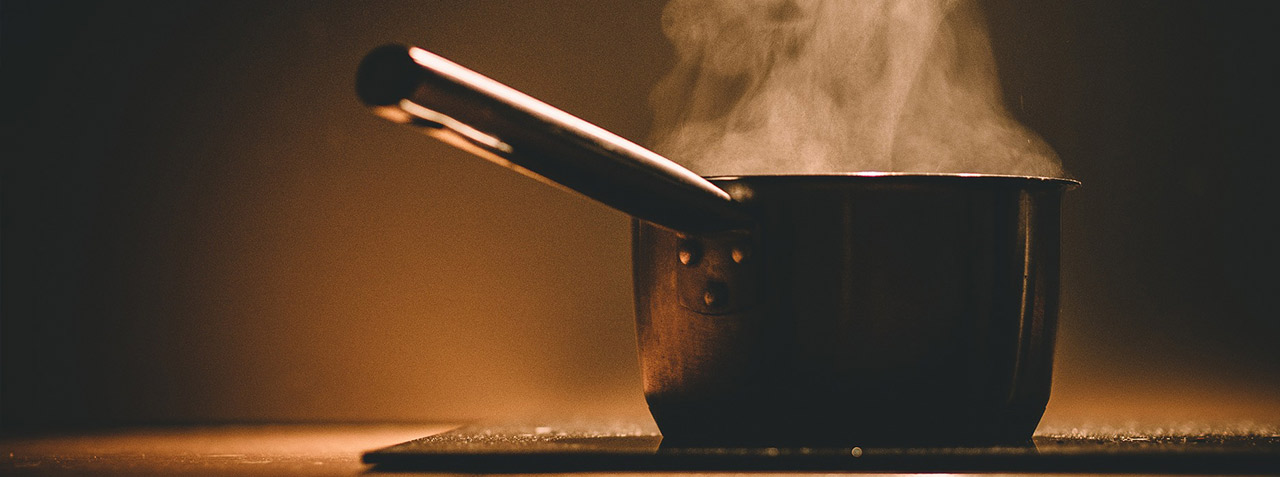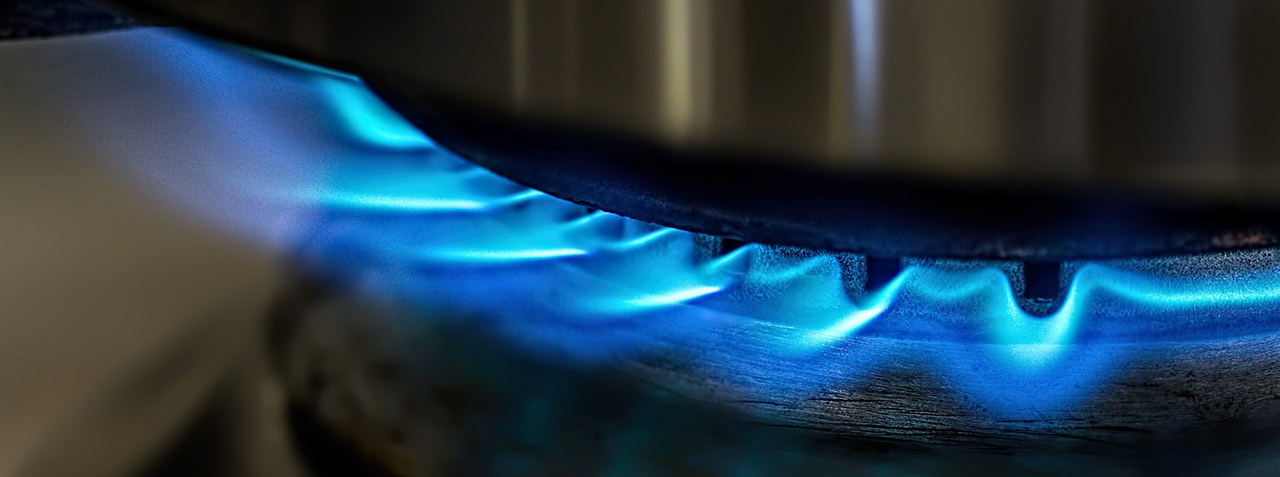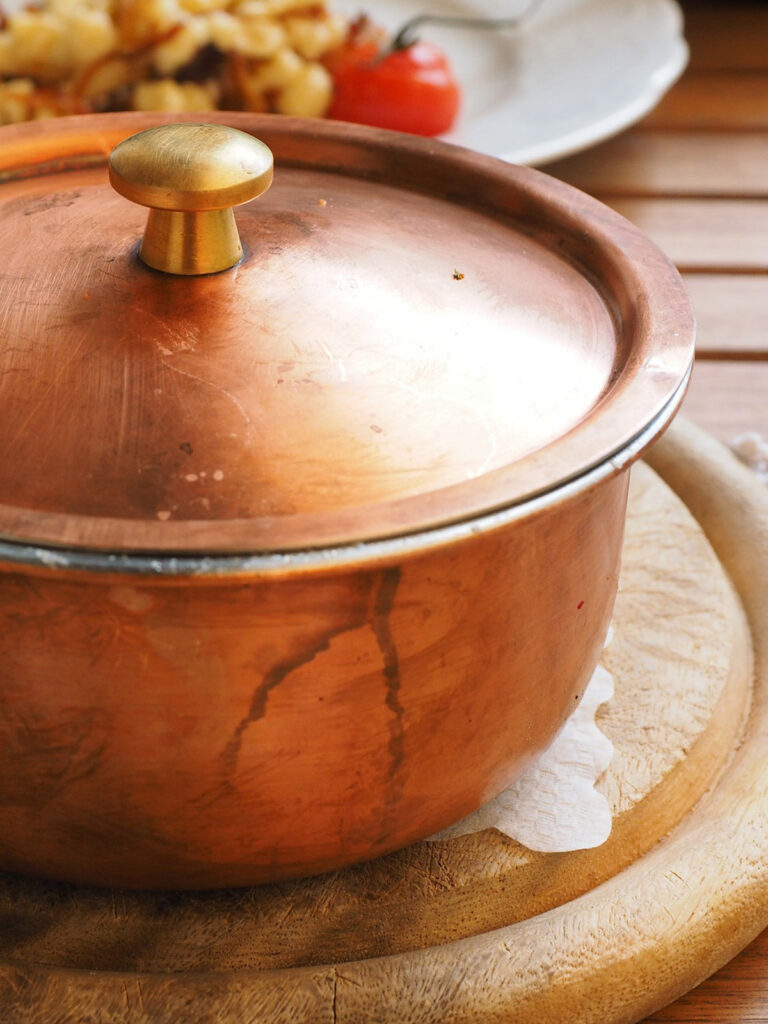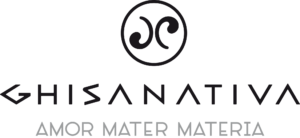
What do you want from a kitchen utensil?
Fonderia Finco’s research meets two requirements:
- to use cookware that does not alter the taste or edibility of food;
- the ability to conduct heat evenly and effectively so that no hot spots are formed in it on which food can burn.
The only material that meets these characteristics is cast iron, provided it is properly manufactured.
Cooking utensils are made of different materials, depending on their function: the characteristics of a pan suitable for frying will certainly be different from those of a pan for boiling, and so on. Here we will analyse the pros and cons of
- cooking materials.
- thermal conductivity;
- resistance to impact;
- durability;
- ease of maintenance;
- more or less flat bottom surface;
- hygienic characteristics.
Cooking on copper
Remember the pots and pans hanging on the living room walls or from grandma’s ceiling beams?
In recent years there has been a noticeable rediscovery of copper pots and stills. They can be found in supermarkets but above all at village fairs and markets. But let’s look at the pros and cons together:
The pros of copper
- copper has high thermal conductivity, so a copper pan heats up equally well on the bottom and the walls, cooking food evenly;
- copper is the only metal found in its natural state and the first used by man;
- food hardly sticks;
- the cookware has a practically unlimited lifespan and is shock-resistant.
The cons of copper
- copper has a high affinity for oxygen and also for sulfur, so it forms a greenish film when exposed to air. This is a very serious contraindication, as the oxide coating is porous and powdery, and copper ions tend to enter food;
- the human body eliminates copper with difficulty and its accumulation in the body can cause major gastrointestinal problems;
- the problem of metal migration has been solved by coating copper utensils with a layer of tin, which requires some precautions in use and cleaning. When first used, tin-plated copper pans should be greased on the inside with oil and then rinsed;
- They cannot be placed on the fire without any food inside and are very sensitive to scratches and abrasions caused by metal spoons and forks.
For further information, click on this article from La Stampa
Cooking on alluminium
Pots, pans, coffee pots, moulds, and baking trays, which used to be made of copper, have become the almost exclusive preserve of aluminum since the early 20th century. We Italians are the leading European producers of aluminum. And aluminum, a practical material, is widely used in traditional catering.
Let’s take a look at the pros and cons of this material below:
The pros of aluminium
- versatile and practical to use;
- it oxidises very slowly and only at the surface layer;
- it is easy to maintain and low cost.
Aluminum has almost replaced copper (which weighs three times as much) since the mid-20th century.
The cons of aluminium
- microparticles of ions disperse in the food;
- it does not promote the Maillard reaction;
- aluminium easily deforms;
- aluminium turns light sauces unpleasantly brown and can flake and become porous over time and with use;
- aluminium cookware intensifies the sulphurous smell of cabbage, broccoli and other similar vegetables.
Indigestion of aluminium microparticles or ions mainly causes damage to the brain and also interferes with certain neurotransmitters. Aluminium is not only found in pots and pans but is also present in many product packages, including soft drink cans.
Read this paper available on ResearchGate
Cooking on stainless steel
Stainless steel came into the world to give better resistance than iron, which corrodes if left untreated. There are different qualities of stainless steel. Generally, the ones commonly used for kitchen utensils contain about 15% chromium and can also have nickel, which triggers allergic reactions on the skin and elsewhere. Needless to say, these “ingredients” are needed for the chemical stability of the product.
In 18/10 stainless steel, 10 parts of nickel have been added to the 18 parts of chromium. If you are allergic to nickel, you should choose stainless steel marked 18/C.
The pros of stainless steel
- it is durable and resistant;
- it does not rust or deform;
- it is resistant to corrosion;
- it is very easy to clean.
The cons of stainless steel
- it is a very poor conductor of heat, so much so that it forms hot spots and burns food, which easily sticks to the bottom at the flame;
- it does not promote the Maillard reaction on food;
- it tends to release heavy metal particles in contact with acidic compounds.
In general, it is a good idea to avoid leaving cooked food in contact with stainless steel surfaces for a long time, as well as cooking very acidic dishes such as tomatoes and sweet and sour sauces.
A variant of stainless steel available on the market is the non-stick coated version. It is usually used in the manufacture of frying pans and saucepans to simplify the cooking of dishes that would tend to stick if cooked with uncoated steel utensils. It should be noted that the combination of a non-stick coating with a material of low thermal conductivity such as steel can create problems of overheating of the coating.
Cooking on ceramics
Ceramic materials are mixtures of different compounds, mainly oxides of silicon, aluminium, and magnesium. The use of moulded clay to make simple pottery dates back 900 years. The Chinese invented porcelain, a white but transparent ceramic made by mixing kaolin, a very light-colored clay, with a natural silicate, and firing it at a high temperature.
The pros of ceramics
- using ceramics in slow processes such as baking is optimal;
- ceramics retain heat at the expense of copper and aluminium;
- they are very resistant to corrosion.
The cons of ceramics
- they are bad conductors of heat
- ceramics expand and contract significantly when heated and cooled;
- sudden changes create mechanical stresses which in turn cause the material to crack.
Glass is a special type of ceramic that contains mainly silica. Glass is resistant but not immune to the effects of heat. Tempered glass is another good material that unfortunately comes at a high cost.
The pros of glass
- great for microwaves and ovens
- it is convenient
- does not react chemically with any ingredient
The cons of glass
- it is limited in terms of carrying out all types of cooking
Cooking on terracotta
- Terracotta is said to give food harmonious vibrations and energy, enhancing its taste and qualities.
The cons of terracotta
- fragile material;
- these pans are often painted with lead-based enamels and colours;
- it requires care to prevent it from absorbing the flavours of the food;
Terracotta pans should be washed immediately after use with water and vinegar or lemon.




